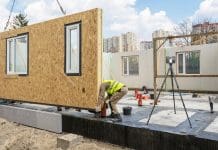Mark Farmer, founding director of Cast Consultancy and author of the landmark Modernise or Die review, looks at the rise of modular construction and examines whether the sector is really ready for take-off
The recent announcement that Goldman Sachs has refinanced the Top Hat modular homebuilding platform has sent a few ripples through the UK homebuilding industry, and rightly so. What it suggests is that private, institutional-grade capital is starting to see the emerging opportunity to significantly disrupt existing delivery models. This is no longer some seemingly distant story from the other side of the pond about technology companies like Amazon or Google investing in modular or billion-dollar investments into the likes of Katerra. This is now a UK-based revolution that builds on the pioneering steps of Legal & General and Berkeley Group to invest significantly in establishing a new model of delivery and overcoming the resistance to change of most traditional housebuilders.
While the concept of modular housing (and I will focus here on ‘modular’ or Category 1 MMC to use the UK government’s definition is nothing new, but growing discontent with the outcome of traditional means of producing new homes has sparked a wave of interest in this approach.
That interest is split between those still grappling with inherent suspicion and scepticism about something that has never managed to take off in this country and has, in some instances, been done poorly and, on the other hand, those with genuine excitement that we are at the dawn of a new wave of advanced home manufacturing, all enabled by unprecedented technology. Neither of these bookends really reflect the current real state of the offsite market.
Many of the problems this sector has faced are due to the offsite manufacturing supply chain not being vertically integrated. As such, it is effectively a series of manufacturers wanting to sell modules and, in some cases, development management and site construction services to developers, investors or landowners.
The need for transactional interfaces that link manufactured housing products with land is the critical distinction between manufacturing a house and manufacturing a car. The inability to bring these two critical elements together is often the fatal flaw that has held back the concept of modular housing.
In the last two to three years, the increasing interest in modular housing has not been reflected in increasing real activity. The point of breakdown is land-led developers or investors not getting comfortable with the concept of early engagement with a manufacturing partner, often without the usual default comfort blanket of a competitive bidding process. This behavioural inertia prevents design-for-manufacturing thinking being deployed at the highest value opportunity – prior to fixing a planning application.
Added to the engagement and procurement problems, there are financing issues – part perception, part reality – both in terms of mortgage availability and insurance (both issues that are being forthrightly addressed by a MHCG working group that I chair) and also, crucially, development finance being wary of advanced payments or the risk of a thinly capitalised manufacturer going bust part-way through a development and then being unable to complete the project due to the uniqueness of the building system.
Finally, there are ongoing concerns about the ability of full volumetric modular solutions to be able to satisfy planners and the public in terms of design aesthetic and visual quality. The expectation, often quite rightly, is that there is limited design flexibility in how a modular home can look.
These last two points above stand out for me as to why the Goldman Sachs deal with Top Hat is potentially of such importance. The level of capitalisation that Goldman Sachs brings to Top Hat completely changes the game when it comes to any concerns about covenant strength and perception of solvency risk.
However, that alone is not enough for success. Any well-funded modular provider fundamentally needs an attractive proposition from a design and product quality perspective, as well as a strong commercial benefits case. The fact that Goldman Sachs has backed this platform is no doubt a reflection of the importance attributed to the level of technology enablement and design-led thinking that sits behind this proposition and its ability to drive scale efficiencies.
The fact that Top Hat and Goldman Sachs are also putting their money where their mouth is and building a complex, heritage-led development using their modular products at Kitchener Barracks, Chatham, is also an important proof-of-concept to build confidence for third-party prospective clients.
Against this backdrop, the importance of design thinking comes to the fore. In a period when the government has rightly recognised the growing importance of quality not just quantity, the advancement of the modular housing market has to be able to prove not just technical build quality and longevity but the inherent manufacturing process versatility to address a range of modern contemporary and traditional vernaculars and avoid so-called ‘cookie cutter’ outcomes. It is why I believe Berkeley Group’s approach to its modular solution is so impressive.
Modular designs have to not just be optimised for manufacture but for whole life/circular economy performance, consumer satisfaction, better community and societal outcomes, carbon and environmental sustainability amongst other things. An inability for traditional homebuilding to think in these ways creates an opportunity for modular to lead this broader debate. If it looks to just conform to the usual conventions and go head-to-head with housebuilders, I suspect the offsite market will struggle to take off. It is not enough, albeit it is true, to say we are running out of skilled traditional resources so we will be forced to build in factories. The critical thing is what we are building as an outcome, everything else is purely a means to an end.
I think such more holistic thinking is going to drive real value in the future, not just the current focus on land value and speculation. It’s difficult to see where that change might come from but it has to start somewhere.
I am also nervous that people think modular might be ‘cheap’ at scale. If that benefit simply accrues though to a developer or a landowner through a higher land value then the real benefit of manufacturing quality homes will have been utterly lost – back to the decoupled product and land debate!
This reformation of thinking is certainly part of the Construction Innovation Hub’s mission to drive digital, manufacturing and performance thinking against a much wider perspective of value and I am looking forward to being part of the that debate as a member of their newly formed Industry Board.
I am also enthused that my work as trustee of MOBIE provides an opportunity to help educate young people in a whole set of new values and paradigms about housing and to train not just people who will design, manufacture and assemble modular homes, but crucially the developers and investors who will be the new modular clients of the future and the planners and policymakers who will be the custodians of a new approach to what good looks like.
Mark Farmer
Founding director & CEO
Cast Consultancy
Tel: +44 (0)203 931 0200
mark.farmer@cast-consultancy.com
Twitter: @mfarmer_resi
Twitter: @castconsultancy


















I tried to present an outline business case for the local authority I work for to create housing designs (which incorporate adaptable modular designs with hardwired technology) for Supported Living accommodation but found no-one was remotely interested or enthusiastic.
I also tried to present a further outline to the Local Government Association to get funding to consult with a housing industry expert to work up a full business case to build a series of modular show houses designed to accommodate LD or aging residents using data and information from Health and Social Care. Trying to espouse the use of modular design to support people as they age and adapt to live in their own home longer. They didn’t see any merit either.
Where did I go wrong if there are/were moves in the housing industry and Government to promote and develop the modular housing industry? i still have a vision but there is no take up of the idea at all.